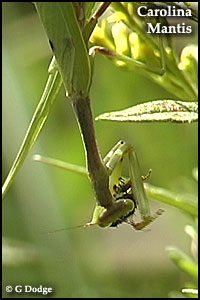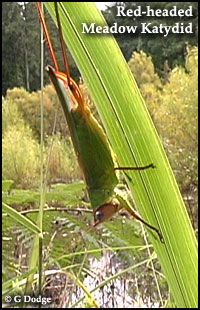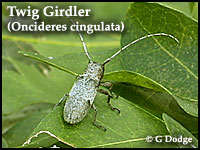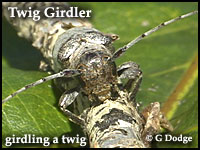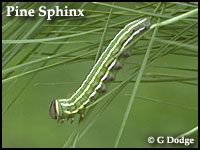Despite a general decrease in dragonfly activity, several dragonflies are still being seen in small numbers including Common Green Darner, Black Saddlebags and Wandering Glider. All three of these dragonfly species are known to move with the seasons. With the winds out of the north, mostly northeast for a good part of the period, I’m inclined to think that the individuals that are being seen are indeed migrants. Not on the move but still fairly common are Blue Dashers.
So far this year I’ve tallied 25 species of dragonfly. I expect that number to increase by at least one before the fall ends. Meadowhawks are late season fliers and I suspect that there will be a few Autumn Meadowhawks about in October and November. Stay tuned.
For three consecutive days during the third week of September I observed a Carolina Mantis perched amongst the bright yellow flowers of Goldenrod growing alongside the Wetlands. At some point each day the mantis held a Bumble Bee tightly in its grip, chewing away on the unfortunate bee. Goldenrod is a good place to look for mantids at this time of year as the flowers are visited by many insects, which is what a mantis eats.
The Carolina Mantis is the native mantis in our area. The rather large (up to 4”) Chinese Mantis that most folks are familiar with was introduced to help control insect pest species. Of course, Chinese Mantids will snatch up anything that comes within reach: pest insects, beneficial insects, even hummingbirds. The Carolina Mantis only gets to about 2.5” in length and can be either mottled gray or green like the one in the image at left (munching on a bee, of course).
Orthoptera species, that is, grasshoppers, katydids, and crickets, are abundant. Grasshoppers of various species can be seen on the paved path, in the grass along the path, and on the various inanimate objects around the Explore the Wild/Catch the Wind Loop. I’ve seen adult Red-headed Meadow Katydids (photo below) on the tall grass lining the paved path around the Loop as well as many nymphs of that and other katydid species. Pass your hand or your foot over the clover or mowed grass along the path and you’re likely to see crickets of various sizes scatter.
I picked up a beetle near the vending machines in Catch the Wind. It was a longhorned beetle although I didn’t know the species; wasn’t even sure of the family in which it belonged. I got a clue when I placed the beetle on an oak leaf with the twig still attached in order to videotape the still unknown insect (images at left) . The beetle soon crawled off of the leaf and onto the twig. It began to girdle the twig.
Thanks to Michael C. Thomas and BugGuide.Net, I discovered that the beetle is a Twig Girdler (Oncideres cingulata). These beetles lay eggs under the bark of a twig. They then girdle the twig which dries and falls to the ground, the larva developing inside the twig on the ground.
While walking the Explore the Wild/Catch the Wind Loop I came upon a very strange looking creature ambling across the paved surface of the path. It appeared to be some kind of larva, a beetle larva, either a soldier beetle or perhaps a firefly (Lightning Bug). What first struck me about the insect was its tiny head which could extend and retract much like a turtle’s. Another odd thing was that it used the tip of its abdomen as a kind of 7th leg in moving along the path. Thanks again to BugGuide.Net. This insect appears to be a firefly larva, Photinus pyralis, a common species in our area (photos below).
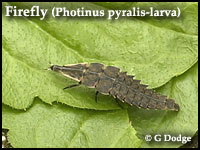
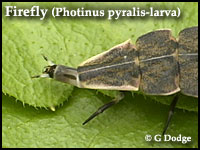
Several Two-lined Spittlebugs (adults) were observed at the Wetlands Overlook near the Lemur House. The nymphs of this attractive insect are the critters that form masses of “spit” on vegetation to hide in while they mature during the summer.
Cloudless Sulphurs continue to fly through to the south. In fact, I’ve seen more of their caterpillars on the Partridge Pea around the Loop (see Cloudless Sulphur Caterpillars, Explore the Wild Journal, September 1-15, 2008).
The most consistently seen butterflies have been Eastern-tailed Blue and Pearl Crescent. A Red-banded Hairstreak was seen on Goldenrod next to the Wetlands. Gray Hairstreak, Monarch, Viceroy, Hackberry Emperor, and Fiery Skipper and other skippers were also seen.
Caterpillars. Besides the Cloudless Sulphur larvae mentioned above, the list of caterpillars seen munching on leaves and crawling around the Explore the Wild/Catch the Wind Loop continues to grow. More Red-humped Caterpillars were seen on Redbud (see Red-humped Caterpillars, Explore the Wild Journal, July 16-31 & August 1-15, 2008). A Contracted Datana was seen hiking across the paved path as was a Sycamore Tussock Moth larva. And finally, a Pine Sphinx.
Pine Sphinx larvae are in the same group of caterpillars as the familiar Tobacco and Tomato Hornworms (Carolina Sphinx and Five-spotted Sphinx respectively). Unlike the other two sphinx caterpillars, Pine Sphinx larvae don’t have a horn on their rear ends. They’re not quite as robust or as long either, about 2 inches in length. And, again unlike the other two sphinx larvae, they wear longitudinal stripes along their sides, which seems more appropriate attire for life in the pines (image below).
After the rains of the 24th & 25th I came upon a large wasp (about 35 mm) in a small pool of water. It was clinging to a cluster of pine needles in an attempt to climb out of the water and get airborne. It was a horntail. As best as I can determine it’s a Pigeon Horntail (Tremex columba), also called Pigeon Tremex (image below).

The intimidating looking projection on the horntail in the photo below (see arrow in image) is a sheath that houses an ovipositor. These insects drill through the bark of a dead or dying tree and deposit an egg into the wood. A fungus is also injected into the wood which softens the wood, allowing the larva that hatches from the egg easy going as it tunnels through the wood. These insects don’t sting.

